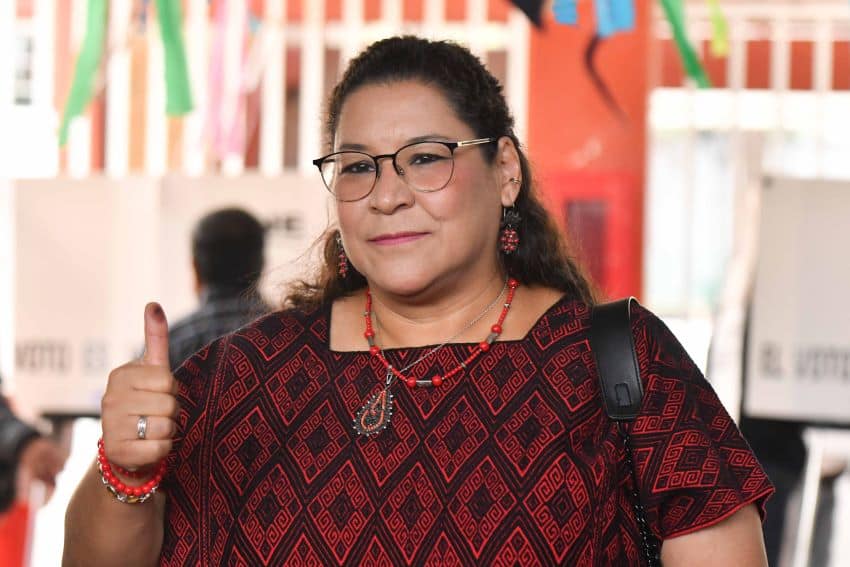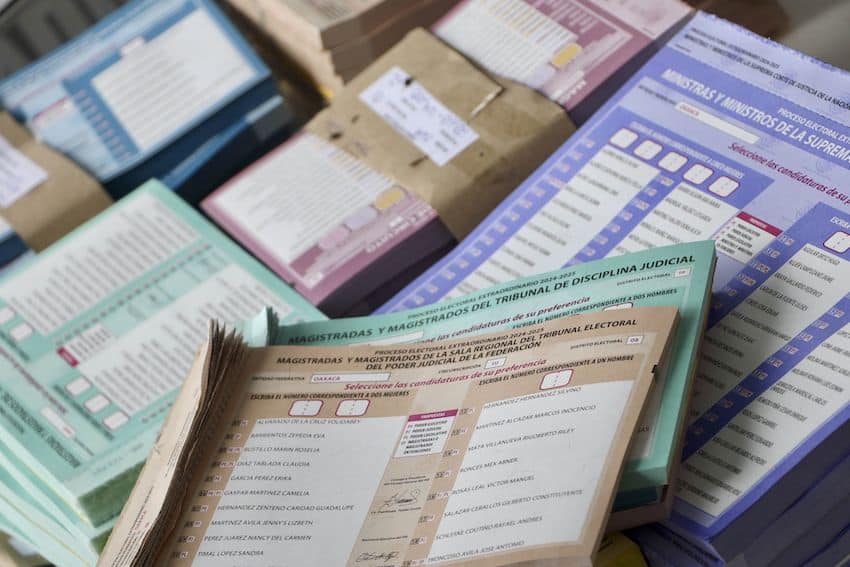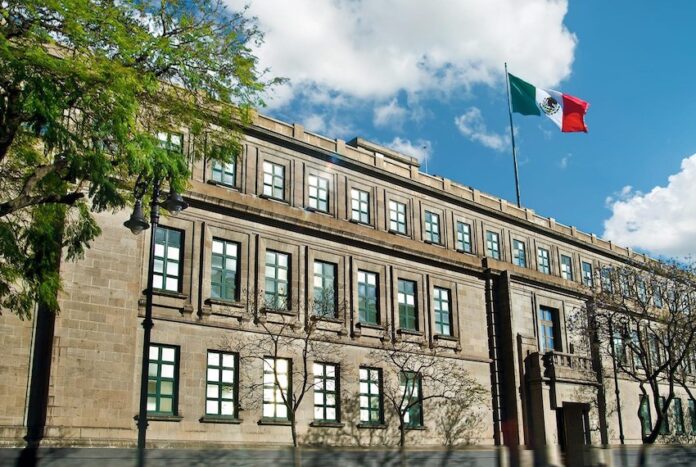Hugo Aguilar Ortiz, a Mixtec man from Oaxaca who is currently an official with the National Institute of Indigenous Peoples (INPI), is set to become the next chief justice of Mexico’s Supreme Court (SCJN), after he attracted more support than any other candidate in the election for justices on Sunday.
The 51-year-old lawyer and the other candidates set to become justices are affiliated with, seen as sympathetic to, or were at least tacitly supported by the ruling Morena party, a situation that government critics argue will eliminate a vital check on executive and legislative power.

With 87% of the vote counted, Aguilar’s vote tally stood at just under 4.94 million, ahead of current Supreme Court Justice Lenia Batres Guadarrama on 4.69 million votes, according to the National Electoral Institute (INE).
The candidate who attracts the most votes will be appointed as the chief justice, or presidente, of the SCJN for a two-year term. The nine justices elected on Sunday will assume their positions on Sept. 1.
The approximately 13 million voters who cast ballots on Sunday were required to select five female candidates for justice and four male ones from a field of over 60 aspirants to Mexico’s highest court.
In accordance with the rules approved for Mexico’s first-ever judicial elections, the nine-person bench will be made up of five women and four men.
The nine candidates set to make up the new SCJN bench were all included on “cheat sheets” distributed to voters by people affiliated with the ruling Morena party.
Their election “signifies the end of the independence of the judicial branch,” Diego Valadés, a former Supreme Court justice, told The Washington Post.
With almost nine in 10 votes counted, the top five female candidates are:
- Lenia Batres Guadarrama: A Supreme Court justice since late 2023.
- Yasmin Esquivel Mossa: A Supreme Court justice since early 2019.
- Loretta Ortiz Ahlf: A Supreme Court justice since late 2021.
- María Estela Ríos González: Top legal adviser to former president Andrés Manuel López Obrador (AMLO) between 2021 and 2024.
- Sara Irene Herrerías Guerra: Head of the human rights department of the Federal Attorney General’s office.
Batres, Esquivel and Ortiz all became Supreme Court justices during the 2018-24 presidency of López Obrador. The eight other current Supreme Court justices chose not to contest the election on Sunday.

Herrerías is well ahead of the female candidate in sixth place in the vote count, meaning that the five women listed above will all serve on the Supreme Court.
The top four male candidates are:
- Hugo Aguilar Ortiz: Indigenous rights coordinator at INPI.
- Giovanni Azael Figueroa Mejía: A lawyer with a doctorate in constitutional law.
- Irving Espinoza Betanzo: A lawyer and anti-corruption magistrate in Mexico City.
- Arístides Rodrigo Guerrero García: A lawyer and former official in Mexico City.
Guerrero is more than 270,000 votes ahead of the male candidate in fifth place in the vote count.
The judicial elections took place due to the approval by Congress last year of a judicial reform put forward by López Obrador, who was an open critic of Mexico’s judiciary and angered by rulings against some of his flagship policies and projects.
Morena got the Supreme Court it wanted
While political parties were prohibited from explicitly promoting candidates that contested the judicial elections, the ruling party, as noted above, did distribute cheat sheets detailing how they would like citizens to vote. Known in Mexico as acordeones (accordions), the cheat sheets were reportedly used by a significant number of voters, who were required to fill out multiple ballots with long lists of candidates on each.
Given that Morena is a highly popular political party and their supporters turned out in large numbers on Sunday, it is no surprise that candidates affiliated with and/or tacitly supported by the party performed well. While opposition parties were denouncing the election, Morena set its mind to getting its supporters to the polls.
According to the Wall Street Journal, the son of AMLO, “Andrés Manuel López Beltrán, operations chief of the ruling Morena party that his father founded, oversaw the political machine that mobilized millions of working-class voters to participate in Sunday’s novel election.”
And thus, Morena was able to get its preferred Supreme Court candidates elected on Sunday.

José Ramón Cossío, another former Supreme Court justice, told The Washington Post the vote on Sunday “wasn’t a free election, but a takeover of the judicial institutions” by Morena.
President Sheinbaum and other government officials argued that the elections were necessary to renew the judiciary and rid it of corruption and other ills. Most Mexicans agree that the nation’s judiciary needs an overhaul, but many warned that holding elections that were likely to result in aligning the courts with the government was not the way to go about it. Sheinbaum has rejected claims that the judiciary will lose its independence.
The Washington Post reported on Tuesday that “diplomats and legal experts said the election could darken the investment climate in Mexico, since businesspeople can no longer look to the courts to uphold the law impartially.”
With a Morena “takeover” of the Supreme Court and other “judicial institutions”, as Cossío put it, the ruling party will effectively control the executive, legislative and judicial branches of government.
Sheinbaum was elected on a Morena party ticket and, in addition to being president, is the leader of the “fourth transformation” political movement founded by López Obrador. She has staunchly defended the 2024 judicial reform as well as virtually all other aspects of the political agenda set by her predecessor before he concluded his presidency last September.
Who is Hugo Aguilar Ortiz?
Born in a small community in the Mixtec region of Oaxaca in 1973, Aguilar completed undergraduate and master’s degrees in law in his native state.
As a lawyer, he once represented the Zapatista National Liberation Army, best known for staging a bloody uprising in the southern state of Chiapas in 1994.
If, as expected, Aguilar becomes the next chief justice of Mexico’s Supreme Court, he will be just the second indigenous person and the second person from Oaxaca to hold that position after former (and highly revered) former president Benito Juárez. He doesn’t have any prior experience as a judge.
View this post on Instagram
The future justice has long been a defender of Indigenous rights as well as a “promoter of the fourth transformation,” the newspaper Reforma reported. He took on his position at INPI in 2018 after working in a range of positions, including as a consultant to the UN Human Rights Office and as deputy minister for Indigenous rights in Oaxaca.
Between 1996 and 2010, Aguilar represented more than 25 Indigenous communities in Oaxaca in land disputes, political disputes and other matters, according to the Milenio newspaper. He succeeded in establishing precedents in local and federal courts, including the SCJN, Milenio said.
While she didn’t promote any individual candidates, Sheinbaum did say she would like to see Indigenous people serving as Supreme Court justices.
“We want Indigenous representation in the Court, we want justice,” she said during an event in Benito Juárez’s birthplace on March 21, the 219th anniversary of the former president’s birth.
On Tuesday, Sheinbaum said that Aguilar is “a very recognized lawyer” and “has the credentials to join the court.”
On a website that was created to support his candidacy, Aguilar said he “acquired greater awareness” of his identity as a Mixtec person during his adolescence.
He said he also “lived the exclusion and injustices associated” with being an Indigenous person.
“In this context, I had the certainty that my life aspiration … [would be] the fight for justice,” Aguilar said.
During a recent interview with Milenio Televisión, he said that the justice system in Mexico “practically hasn’t existed for Indigenous people.”
“The justice system has functioned to serve other interests. Their rights, ways of organization, traditions and cultural elements haven’t been in the constitution and as a result … [Indigenous people] haven’t been part of the justice system,” Aguilar said.
His campaign slogan was “¡Ya nos toca!” (It’s our turn), expressing his view that now is the time for greater representation of Indigenous voices and perspectives in Mexico’s judiciary.
What will guide Aguilar in his work as chief justice?
On his INE candidate page, the future Supreme Court justice set out his three main proposals.
- For justice to be consistent with reality, judicial functions should be carried out in the field, incorporating on-site visits, dialogue with individuals, and an effort to understand the actual situation being presented, without excessive formalities. Likewise, an open attitude should be adopted to learn from others — their uniqueness, context, and reality. In this way, the arguments supporting decisions will not be mere formal reasoning, but will be grounded in reality.
- It must be kept in mind that judicial decisions are final, and that no one possesses the absolute truth. In this regard, a multidisciplinary approach should be strengthened by involving specialized bodies in all matters and by expanding and consolidating the role of Amicus Curiae [friend of the court]. Likewise, dialogue with the parties should be prioritized in order to examine disputes more thoroughly.
- The judicial function should not be an obstacle to social change. Attention must be paid to the national context when resolving central issues of public life. To this end, republican dialogue should be prioritized between the branches of the Union, the federal entities, municipalities, and Indigenous and Afro-Mexican peoples and communities.
With reports from Reforma, El Economista, Milenio, The Washington Post, El Financiero and La Jornada
